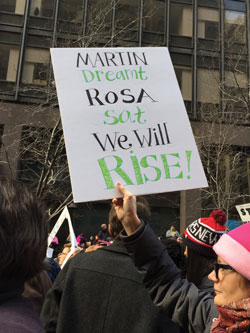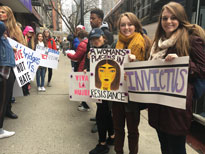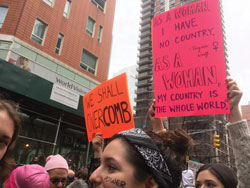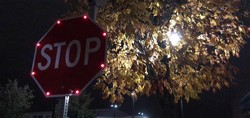Students Demonstrate Peacefully in New York City
 Over 40 students, faculty, and other members of the University community took to the streets in the Women’s March with more than 300,000 peaceful demonstrators in a trip hosted by the Gender Studies Program and the School of Humanities and Social Sciences on Saturday, Jan. 21.
Over 40 students, faculty, and other members of the University community took to the streets in the Women’s March with more than 300,000 peaceful demonstrators in a trip hosted by the Gender Studies Program and the School of Humanities and Social Sciences on Saturday, Jan. 21.
Although the original focus of the day was on the main Women’s March in Washington D.C., the focus broadened as similar “sister marches” occurred simultaneously across the U.S. and around the world. Men and women of all ages, gathered in the streets of cities like Los Angeles, New York City, Chicago, Sydney, London, and Cape Town; a march was also held closer to home in Asbury Park.
According to politicususa.com the Women’s March was the largest peaceful one-day protest in U.S. history with an estimated 2.9 million participants.
Students were invited through email to reserve bus seats to the march in New York City before, and after the winter break. The bus left the University around 9:15 a.m. Saturday morning. Upon arrival into New York City the group joined other protesters on a route that began near 45th street and ended nearly two miles away at the steps of Trump Towers, on 721 5th Avenue.
 According to Corey Wrenn, Director of the Gender Studies program and organizer of the trip, the march was a pivotal moment in global history. She said, “As someone who studies inequality, it brings me an incredible feeling of hope. I saw a show of solidarity on January 21 that has never been presented in such a way before. This election has a lot of people down and a lot of people rightfully fearful for their safety and well-being.”
According to Corey Wrenn, Director of the Gender Studies program and organizer of the trip, the march was a pivotal moment in global history. She said, “As someone who studies inequality, it brings me an incredible feeling of hope. I saw a show of solidarity on January 21 that has never been presented in such a way before. This election has a lot of people down and a lot of people rightfully fearful for their safety and well-being.”
“January 21 made it clear that those who wish to strip rights from women, people of color, (Lesbian, Gay, Bisexual, Trans, Queer/Questioning, and others) LGBT+ persons, disabled persons, immigrants, and other disenfranchised persons are in the minority. Americans stepped up on Saturday. The world stepped up,” Wrenn continued.
 Kayvon Paul, a sophomore political science student, was one of the few male students to attend the trip. He said, “Donald Trump’s administration threatens the rights of women, and it was an incredible experience to be apart of a protest that recognizes this. I have five sisters and I went to the Women’s March for them, and their future.”
Kayvon Paul, a sophomore political science student, was one of the few male students to attend the trip. He said, “Donald Trump’s administration threatens the rights of women, and it was an incredible experience to be apart of a protest that recognizes this. I have five sisters and I went to the Women’s March for them, and their future.”
In New York City as well as other “sister marches”, pink hats with cat ears dotted the heads of marchers as far as the eye could see. Varying signs showcased the diverse agendas of demonstrators. Some showed support for women’s rights with statements like, “women’s rights are human rights.” Some advocated for the Black Lives Matter movement, while others targeted the newly elected president, Donald J. Trump.
Elizabeth Carmines, a juniorpolitical science and sociology student, attended the trip. She marched alongside other demonstrators in the cold for several hours, but she did not complain. “Being a part of the march was surreal; I could never have imagined what it would be like to stand among hundreds of thousands of individuals who were all passionate about the same issues. I was so impressed with how peaceful it truly was and how, despite it being a long day, the group’s spirits remained high,” Carmines said.
According to Nancy Mezey, Associate Dean of Faculty and Academic Affairs for the McMurray School of Humanities and Social Science, the protest was unique to any other historical election response. She said, “I cannot think of another election that has prompted millions of people around the world to join voices in solidarity against the policies they anticipate coming from the new presidential administration.”
Mezey also deduced that the march was a clear warning to the new administration. She said, “The fact that millions of people in every U.S. state and over 30 countries protested against the past actions and promised policies that limit the rights and future of so many groups of people, tells our new president that he has much work to do if he wants to be everyone’s president and support the United States’ democratic principles.”
Sydney Underhill, a graduate public policy student, went on the trip to the Women’s March in New York and agrees with Mezey’s assertions. She said, “This march, the largest movement in American history and an unprecedented global phenomenon, is sending a direct message to Congress, the new administration, and leaders worldwide that we, the progressive majority, refuse to comply with their oppressive politics.”
“Any actions rooted in racism, sexism, xenophobia, classism, ableism, trans/homophobia, etc. will be met with mass resistance,” Underhill continued.
Trump responded to the protests via twitter on Sunday, Jan. 22. He wrote, “Peaceful protests are a hallmark of our democracy. Even if I don’t always agree, I recognize the rights of people to express their views.”
Mezey encourages students to think about ways that they can stay involved at the University and through activism so that the march isn’t just a “one and done.”
Mezey said, “Students should always care about politics and social issues. The policies of today affect the lives of tomorrow…the legacy of any legislator, but particularly the President of the United States, is long lasting. Getting involved in politics and social justice work now can help shape the future that students, their children, and even their grandchildren will inherit.None of us should ever be complacent.”
Nevertheless, some students at the University are already non-complacent. On Saturday they marched for what they believed, in the largest peaceful march in U.S. history.
PHOTOS COURTESY of Corey Wrenn



